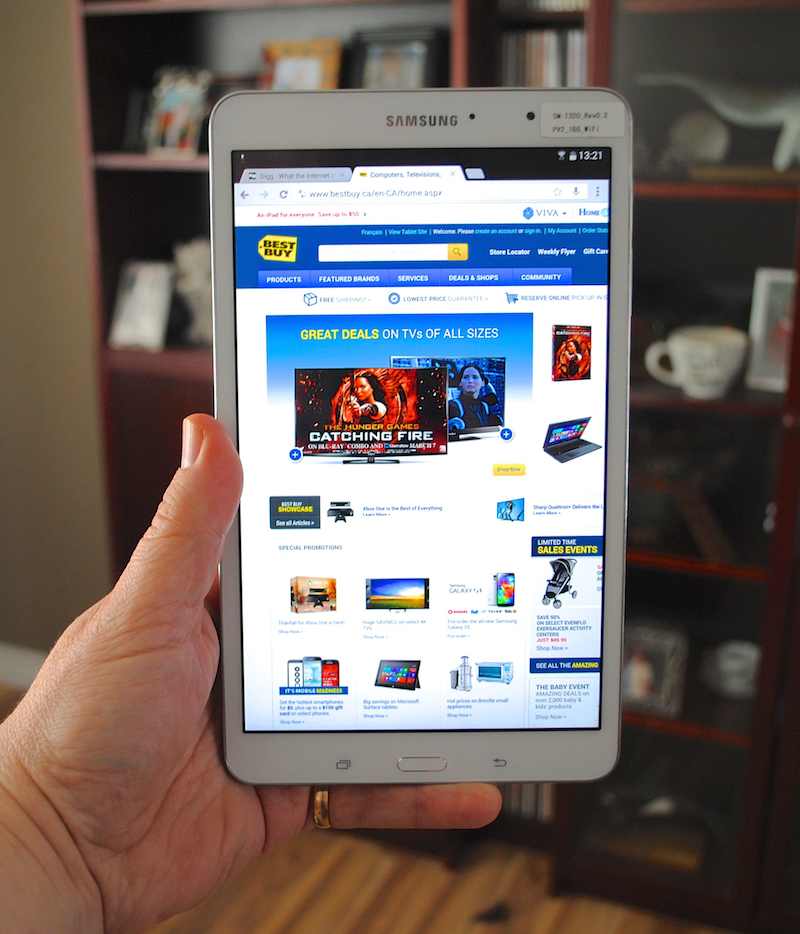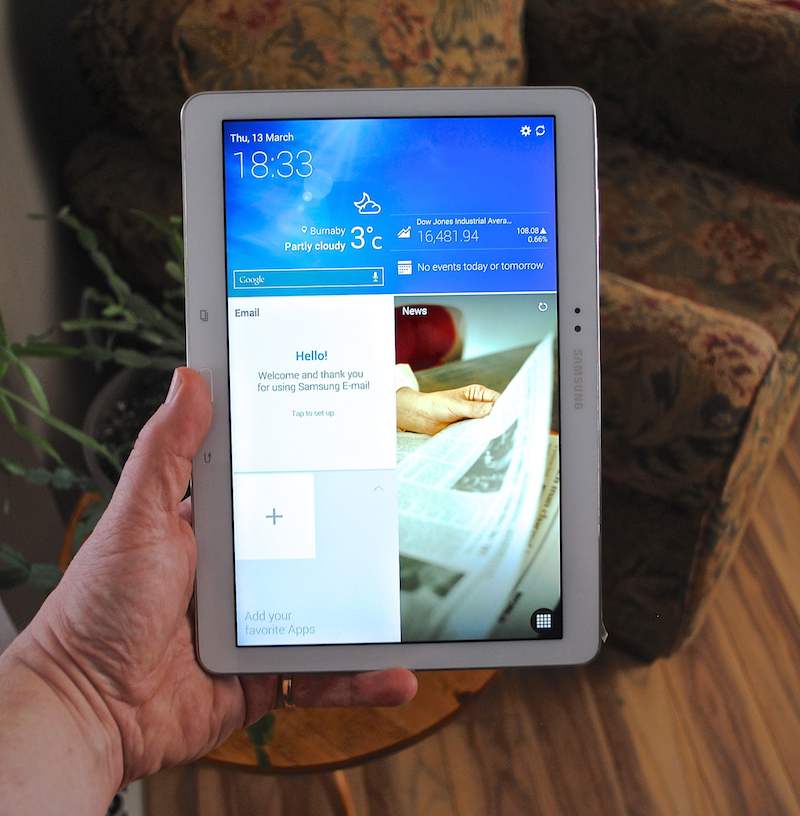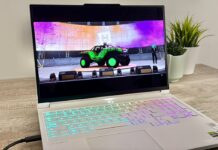
L to R, the Galaxy TabPRO 10.1, Galaxy NotePRO 12.2 and Galaxy TabPRO 8.4
One of the cool aspects of this job is being able to try out a hotly anticipated new device before it’s officially available. What’s even cooler is when a manufacturer sends you a whole box of new gadgets to review. That was the case when I cracked open the shipment from Samsung to find the new Galaxy NotePRO 12.2, Galaxy TabPRO 8.4 and Galaxy TabPRO 10.1 tablets. You can buy all three now at Best Buy, but I had the opportunity to get to know them before they hit the shelves. While I was especially impressed by the Galaxy NotePRO 12.2 (with its massive 12.2-inch, four million pixel display), all three PRO models are likely to please Android tablet fans, and offer a solid choice for prosumers and those looking for a business-friendly option.
Why the PRO designation?
This is a question we’ve tackled previously, when Samsung first announced the new tablets. The answer is that Samsung has identified a market of prosumer and professional tablet users —those who want the best experience possible, push the limits of tablet capabilities and might even choose to use their tablet as a mobile PC replacement.
That means a fast CPU, ultra high resolution display, expandable storage, the fastest Wi-Fi possible, power features like the ability to open multiple windows simultaneously and business-friendly apps like a productivity suite, Samsung’s KNOX security and remote access/control software for a PC.

The Galaxy NotePRO 12.2 dwarfs a typical 7-inch Android tablet
These PRO tablets all pack 2560 x 1600 pixel displays, powerful CPUs, pre-installed apps and services and support the latest and fastest Wi-Fi standard: . They offer 8MP rear cameras (2MP front), an IR Blaster (for TV remote control), Bluetooth 4.0, microSD card storage expansion and each runs Android 4.4 (KitKat). They also feature the premium-look faux leather-stitch backing —available in black or white— first introduced with the Galaxy Note 3.
That’s not to say that a casual tablet user wouldn’t be well-served by these PRO tablets. They make a great choice, particularly the Tab models and those high pixel density displays are awesome for watching movies, playing games and reading text. But that Galaxy NotePRO 12.2 especially —with a display size that rivals many notebook computers— is clearly aimed squarely at the prosumer and professional market.
Galaxy TabPRO 8.4
 If portability is a key concern, but the standard 7-inch Android tablet form factor is just too small, then you’ll love the Galaxy TabPRO 8.4, a tablet that offers just a bit more room.
If portability is a key concern, but the standard 7-inch Android tablet form factor is just too small, then you’ll love the Galaxy TabPRO 8.4, a tablet that offers just a bit more room.
In terms of a display where you can’t see a single pixel, no matter how close you hold it to your face, this is a tough tablet to beat. With the four million+ pixels the PRO series boast squeezed into 8.4 inches, the Galaxy TabPRO 8.4 offers an amazing 359 pixels per inch (ppi).
The Galaxy TabPRO 8.4 can run two apps simultaneously within their own windows, which is a nice option for, say, web surfing while keeping an eye on your e-mail inbox.
It’s a bit small for use as a laptop replacement, but in terms of a powerful tablet that’s easily held in one hand —while offering a bit more viewing area than most in its class— the Galaxy TabPRO 8.4 is a good choice.
Key Specs:
- 8.4-inch LCD display at 2560 x 1600 (359 ppi)
- Quad-core Snapdragon 800 CPU at 2.3 GHZ, with 2MB RAM
- 16GB storage
- 4800 mAh battery rated at up to 10 hours of Internet use
- 21.9 x 12.9 x 0.7 cm, 331g
Galaxy TabPRO 10.1
 The Galaxy TabPRO 10.1 is positioned to be in the sweet spot among prosumer tablet users.
The Galaxy TabPRO 10.1 is positioned to be in the sweet spot among prosumer tablet users.
It has a slight size advantage over some of its key competitors, but is not so large that portability is a concern. Its display is sharp, and large enough that the virtual keyboard (with haptic feedback) makes typing a realistic task. Throw in all the business-friendly apps that Samsung includes and the Galaxy TabPRO 10.1 could cover off the needs of most road warriors while providing a display that’s large enough to effectively use for presentations in a booth.
Using it is mostly a two-handed exercise, although the faux leather back does offer some texture that makes gripping it easier.
The Galaxy TabPRO 10.1 is also big enough and sufficiently powerful to easily take on everyday tasks like web surfing, watching videos or gaming.
Key Specs:
- 10.1-inch LCD display at 2560 x 1600 (299 ppi)
- Exynos 5 octa-core CPU with 2GB RAM
- 16GB storage
- 8220 mAh battery rated at up to 10 hours of Internet use
- 24.3 x 17.1 x 0.7 cm, 469g
Galaxy NotePRO 12.2
The Galaxy NotePRO 12.2 is the one that I ended up spending the most time with, which is somewhat ironic since I’ve been on a tear lately of downsizing my own mobile equipment: I switched my primary tablet to a 7.9-inch version from 9.7-inches and my laptop from a 17-inch model to an 11.6-inch.
Although I thought it was going to be too clumsy for daily use, it’s still thin and lightweight enough that it’s not overwhelmingly large, while the 16:10 aspect ratio means it doesn’t feel as awkward to hold in portrait mode as a 16:9 tablet would.
And that expansive screen means there’s just so much room, that once you use the Galaxy NotePRO 12.2, it’s tough to put down. It’s not quite as pixel dense as the smaller PRO tablets, but at 247 ppi is still very crisp. Web browsing was an excellent experience, it goes without saying that games and video looked amazing, Samsung’s Magazine UX (which resembles Windows 8’s tiles) shone and being able to multitask with four apps open and running in their own windows simultaneously was very cool.

Battery life was on par with what I expect in a tablet too (10 hours or so) despite all those pixels to light and drive.
My sole complaints (other than the obvious drawback of having to lug something this size around) were that the multi-window experience could bog down if maxed out with four windows and each was running a CPU-intensive task (like video). And the S Pen stylus —which in itself offers very useful functionality including being able to take handwritten notes or draw diagrams— seems to have been designed for a hand that’s significantly smaller than mine. It not only felt tiny, it was difficult to scrunch my fingers into a position where I could push its button.
Oh, and there’s no way you’ll catch me holding up a 12.2-inch tablet to snap a photo, even if it does have a decent camera.
Key Specs:
- 12.2-inch LCD display at 2560 x 1600 (247 ppi)
- Exynos 5 octa-core CPU with 3GB RAM
- 32GB storage
- 9500 mAh battery rated at up to 13 hours of Internet use
- USB 3.0
- Includes S Pen stylus
- 29.6 x 20.4 x 0.8 cm, 750g
Go Big or Go Home
All three of Samsung’s PRO models offer a display that’s physically larger than the typical tablets in their class ( a little bigger in the case of the TabPRO 10.1 and a lot bigger with the Galaxy NotePRO 12.2). They also offer more pixels than many of the competing devices. The result is a trio of tablets that not only exceed the needs of any casual user, they’re more than ready to take on the prosumer and professional market.
And in the case of the super-sized Galaxy NotePRO 12.2, it’s possible that Samsung just might repeat the effect it had on the mobile industry with that first Galaxy Note. Some people dismiss a device that’s larger than the rest at first glance, but once you’ve had the opportunity to use it and see the advantages the extra screen real estate offers, it’s clear there will be a market for it. It may even launch an all new category —the tablet equivalent of the phablet.



